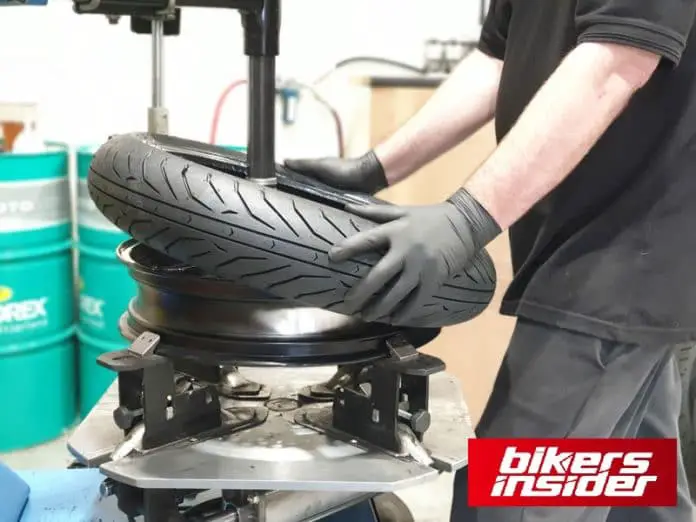Table of Contents
Introduction
We all know that riding on worn-out tyres is risky. In reality, specific reports have demonstrated tyre-related problems. Deterioration and insufficient tread depths might cause accidents.
On average, your tyres should last roughly 5 years. Still, other factors can wear them out faster. Such as riding style, pace, weight, tyre pressures, and suspension setup. Even if you have only been using your tyres for 1 year, they may already show specific indicators that you must replace them.
Monitoring your tyres for wear will ensure your best riding performance. It will put you and other motorists out of harm’s path. The next time you undertake a tyre inspection, watch out for these five indicators that signal you already need to replace your tyres!
1. Wear and tear on tyres
TWI (Tyre Wear Indicator) marks are located on the sidewall of motorcycle tyres. As you drive, the tread depth of your tyres will decrease until it reaches the TWI level. Buying new tyres is necessary when the tread wears down.
Having worn tyres can cause you to lose your balance and stability when driving. A tire’s shape begins to deteriorate with time because of bald spots, irregular patches and one-sided wear on the tread region. If your tyres are worn out in this way, you may find it difficult to stop in the rain because your tyres will lose their ability to grip.
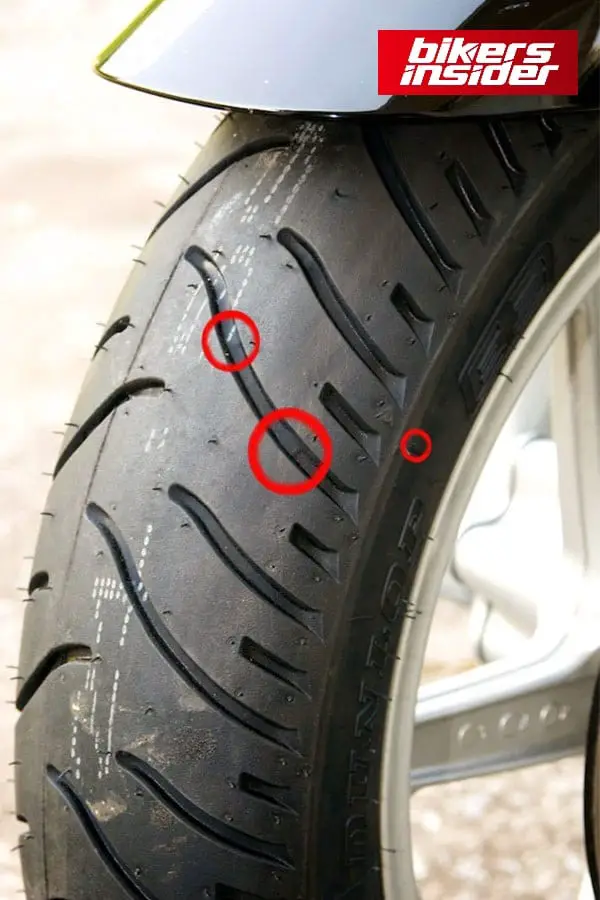
As a result, we advise checking your tyres at least once a month or before and after any lengthy motorcycle road journeys to look for any wear patterns, cracks, cuts, or deformations in the rubber.
2. Unusual pattern of tyre wear
If you notice an unusual pattern of wear on your bike, you likely have mechanical problems or an improper bike setup.
Tyre pressure that is too high
For example, using too much air pressure might cause a pattern in the middle of the tyre.
Your tyre’s contact patch shrinks, and the center is forced to bear the weight of the pressure is too high.
Over-inflating your motorcycle’s tyres increases the possibility of a blowout, making the vehicle unstable and dangerous.
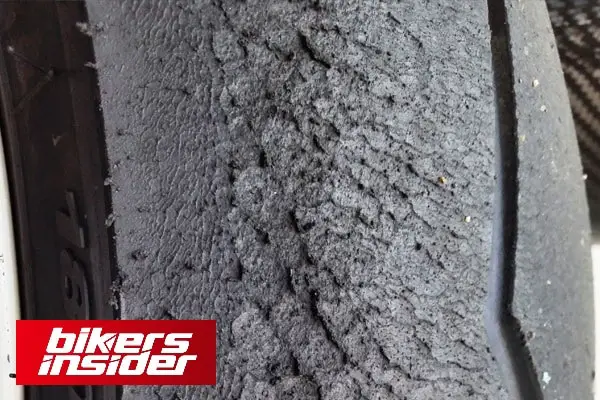
Tyres with low pressure
Low tire pressure might damage your tyres’ outside edges as the contact patch grows and the edges bear more of the load. As an additional precaution, bring the tyre to the service centre if it loses pressure quickly after re-inflating.
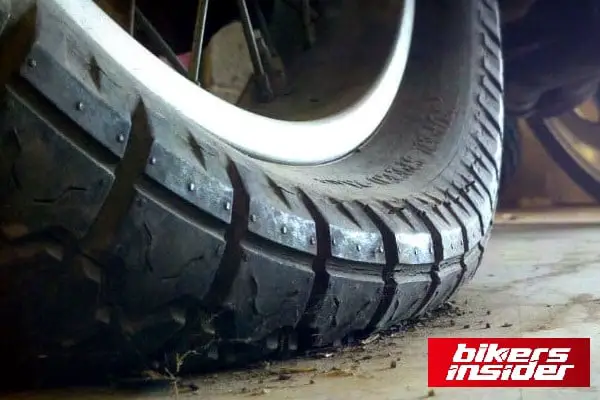
Cupping the treads of tyres
The cupping of the tyre is another peculiar tyre wear pattern to keep an eye on. Shock absorber failure, loose suspension parts, and imbalanced tyres are all possible causes of this type of wear.
Instead of reducing spring oscillations to control tyre movement, worn shock absorbers, for example, can cause your tyres to move excessively. As a result of excessive tyre movement, this pattern may be visible in the tread.
3. Lack of adequate tyre depth
According to a study, bald tyres are the number one reason automobiles end up in the workshop, cited by 80% of auto service experts.
Wet road conditions and bald tyres increase the risk of a motorcycle accident since the rider loses control of their machine while stopping suddenly.
Tires with worn-out treads do not give adequate grip and traction to allow you to move, turn, slow down, and stop safely. As a result, as your tread wears down, the greater the likelihood you may lose control of your motorcycle.
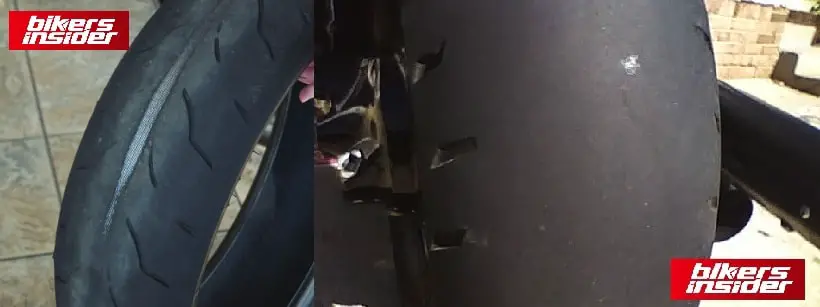
The distance between the top of the tyre and the bottom of the grooves is known as the tread depth. Tires for motorcycles have an initial tread depth of 8 millimeters (mm); however, as they wear down, the thickness decreases to 6 millimeters (mm).
When the tread on your tyres reaches 3mm, it’s time to replace them. Waiting until your tyres have less than 1.5mm of tread left is a recipe for disaster, so replace them as soon as the wear indications.
When tyres have insufficient tread depth, the risk of a car accident rises by as much as 26%.
Tyre wear indicator (TWI)
Tread depth can be checked by inspecting the built-in wear indicator bars (if any) in the tread of your motorbike tyre. Replace your tyres if the bars disappear.
A Tread Wear Indicator (TWI) on the tyre’s sidewall is all you need to determine if your tyres need new air or not. If this is the case, it’s time to replace your vehicle’s tyres.
A mechanic should check your tires as soon as they show signs of odd wear patterns. Of course, if a set of tyres appears to be worn out beyond repair, it should be replaced.
4. Punctures, wounds, or bubbles on the sidewall
Damaged motorbike tyres are a safety hazard on the road. No matter how little the damage appears, it is never a good idea to ride a motorcycle with a punctured tyre or a tyre with cuts or sidewall bubbles.
If you’re stuck in the middle of nowhere and need to patch up a minor cut, a tyre repair kit can come in handy. This is a temporary fix, so be careful to replace it with a new tyre before returning to your regular motorbike routine.
The presence of sidewall bubbles or bulges on a tyre is yet another symptom of wear and tear. Driving forcefully over speed bumps or curbs or slamming into a post is the most typical cause. An obvious bubble or bulge may appear on the tire’s sidewall after a collision.
Repairing sidewall damage is impossible due to the increased risk of tyre failure from cutting into the tread. The damaged tyre should be replaced as soon as feasible.
5. Your bike’s or riding style’s tyres don’t match.
Even though this may seem simple, many motorcycle and riding style-specific tyres are purchased incorrectly, including most riders who acknowledged purchasing the improper tyres.
Ensure that you acquire new tyres that meet the city’s minimal legal standards (e.g., tyre pressure and tread depth). A set of tyres is also included with your motorcycle to guarantee that you get the most out of your safety and performance.
The suggested tyres for cruiser bikes should be used instead of street bike tyres on your cruiser bike. Tread patterns and designs that don’t match the sort of motorcycle you ride might impact how stable and safe you feel while riding.
When to change brake pads of motorcycle
The braking system is a critical component of any motorcycle. It is necessary to regularly replace the brake pads on a motorcycle because they are consumable. However, how long do bicycle brake pads last, and how may they be improved?
The average life span of brake pads
Motorcycle brake pads have an average life span of about 20.000 kilometres. The brake pad compound, rider, weather, and braking technique influence this figure. The best way to tell if your brake pads are worn out is to look at them.
The subject of how long motorcycle brake pads last is controversial. The lifespan of a component is influenced by a wide range of circumstances. It’s hard to put a number on it. It is possible to provide only basic estimations (or averages) and manufacturer expectations, which may not match your experience.
Is there a reason for this when it comes to brake pads? If we look at some of the things that could shorten the life of a brake pad, we can see why.
The composition, manufacturer, and your riding and braking habits all affect how long brake pads last.
Pads wearing caused by:
Quality of the material. A motorcycle’s ability to stop is influenced by the quality and hardness of the brake pad material.
In what manner do you ride your bike. You need Brembo braking systems for city driving. Two fingers on the front brake lever are all we need to rapidly stop when riding in heavy traffic. When brake pads are utilized frequently and violently on the road, they wear out sooner.
Size and weight of your motorcycle. More significantly, heavier motorcycles have a more significant moment of inertia, necessitating greater amounts of braking force. Due to the increased weight of larger bikes, the brake pads wear out more quickly.
The speed of your bike. The quicker a bike accelerates, the more force is needed to bring it to a stop. Using the brakes after going faster causes the pads to wear out faster.
Ceramic brake pads are the most satisfactory all-around performance, but they are also expensive. They also have a softer formula, which means they wear out more quickly than regular brake pads.
The life expectancy of front and rear brake pads is often different. Brake pads for the front and back are rarely replaced simultaneously. A rider’s behavior is more critical than brake pads in this case.
How to check brake pads for wear
Changing brake pads before they start to produce noise is a common misconception. It’s a risky and expensive procedure to go through. Brake discs and rotors can be scratched or scored if old brake pads are not replaced. In the long run, this decision could be costly.
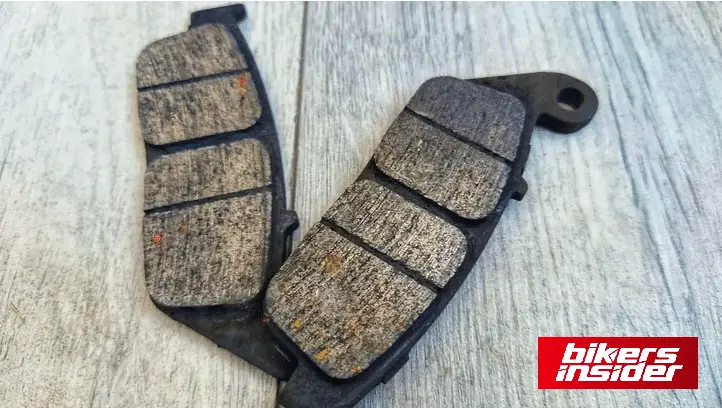
You don’t want to be in an emergency circumstance when you need to brake forcefully and wear your brakes. This is a dangerous situation. In brake pad failure on your motorbike, you run the risk of injury or death. The best way to tell if your brake pads need to be replaced is to perform a visual inspection.
You may detect if your motorcycle’s brake pads need to be replaced just by looking at them. If you light a little torch into the inspection port, the brake pads’ level of wear will be visible.
Conclusion
If you see any physical damage or unusual wear or tread patterns on your tyres, you should get new ones right away. If you need new tyres, be sure they are legal in your state and appropriate for your motorcycle and riding style before purchasing them.
How often you ride your motorcycle, how you ride, and the weather you ride in will affect how long your brake pads survive. Depending on the compound of the brake pads and your riding patterns, you can get a varied estimate of how many miles your brake pads will last.
You must keep this motorcycle component in peak working order at all times. If you don’t do something, your implications as a rider could be grave. When shopping for brake pads, go for the best value you can get for your buck. In my opinion, investing a little more money in higher-quality brake pads is something that every motorcycle rider should do.


